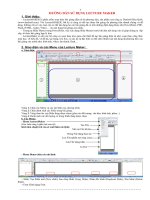Lecture Swallowing, suckling, mastication
Bạn đang xem bản rút gọn của tài liệu. Xem và tải ngay bản đầy đủ của tài liệu tại đây (511.1 KB, 18 trang )
§ FUNCTIONAL ACTIVITIES:
SWALLOWING, SUCKLING, MASTICATION
People’s Teacher
Prof. Hoàng Tử Hùng, DDS, PhD
E:
W: hoangtuhung.com
INTRODUCTION
Swallowing, suckling, mastication are biological functions of the masticatory system
All functional movements are highly coordinated complex neuromuscular events.
Sensory input from structures of the masticatory system (teeth, periodontal
ligament, lips, cheek, TMJ, jaw muscles …)
Swallowing is innate unlearned behavior first occurring in the fetus
Suckling can be observed in human fetus at 20 weeks in utero, although full
swallowing and suckling begin only after approximately at 32 – 36 weeks
Mastication is learned process that matures from suckling with growth and
development of an individual
hoangtuhung.com
SWALLOWING (DEGLUTITION)
hoangtuhung.com
Swallowing is an innate unlearned behavior first occurring in the fetus and is a
complex reflex that is functionally both supportive and protective
Effector sites in the mouth, pharynx, and esophagus elicit the supportive reflex
when exposed to air and food intake
Swallowing protects the larynx from invasion by saliva, esophageal regurgitation,
and nasopharyngeal and tracheal secretions
Swallowing occurs ≈ 600 times a day: 150 times during eating, 50 during sleep,
400 between meals
hoangtuhung.com
Stabilization of mandible is an important part of swallowing
In the infant, the mandible is braced by placing the tongue forward and between
the gum pads or anterior teeth (tongue thrusting): [infantile or visceral swallow]
In normal adult, teeth are used for stabilization of the mandible for swallowing
[adult or somatic swallow]
The characteristic tooth-apart infantile swallowing is quite normal
in adults when swallow liquids or soft boluses
Retention of the infantile swallow in adult can result in labial displacement
(open-bite) of the anterior teeth by powerful tongue muscle
hoangtuhung.com
PHASES OF SWALLOWING
Although swallowing is one continuous act, it may be divided into three phases
1. The oral phase:
The oral phase is under voluntary control
Continuous with mastication, the food mass is moulded
into a bolus by integrated action of the cheek and
tongue muscles and particularly by the action of the
tongue against the hard palate.
Retropulsion of the bolus into the pharynx: the creation
of a pressure gradient between mouth and pharynx: 40 –
50 mmHg intra-oral pressure vs. atmospheric pressure
intra-pharynx
hoangtuhung.com
PHASES OF SWALLOWING (cont’d)
2. Pharynx phase
The pharynx phase occurs reflexly and simultaneously over a 0.1 sec period, in order
to maintain the food-way and protect the airway
The lips are sealed, pharynx opens, the hyoid bone is
raised by mylohyoid muscles, the soft palate is elevated
and the palatopharyngeal muscles constrict to close
the passage of the nasal cavity and mandible is
stabilized in posterior position (MIP or CR)
The epiglottis blocks the laryngeal airway and
interrupts the respiration while the bolus passes. In
this time, there is an equalizing pressure of the middle
ear because of activity of pharyngeal muscle opens the
pharyngeal orifices of the eustachian tube, which are
normally closed
hoangtuhung.com
PHASES OF SWALLOWING (cont’d)
3. Oesopharyngeal phase
This phase begins with the cricopharyngeal muscle relaxes.
The bolus passes through the length of the esophagus into
stomach. Peristaltic waves carry the bolus down the
oesophagus (take 6 – 7seconds)
As the bolus approaches the cardiac sphincter, the sphincter
relaxes and lets it enter stomach
hoangtuhung.com
SUCKLING
Suckling is the process by means of which the infant obtains milk from the
mother’s breast. It is not the same as sucking, even though some negative
pressure is generated within the infant’s mouth.
G. J. Ebrahim, 1978
hoangtuhung.com
Newborns and infants feed by suckling which is a complex process involving the
development of negative pressure or suction in the oral cavity combined with
jaw movements to express the milk from the nipple
During suckling, the nipple is suckled deep into the posterior part of the mouth
to the junction of the hard and soft palate
Suckling can be divided into two phases:
1. Lowering of the jaw with a forward and downward displacement of the body
of the tongue*, and
2. Elevation of the jaw with an upward and backward displacement of the tongue
*Infant sucking rate ranges 40 – 90 suck/minute
The negative pressure ranges 20 – 200 mmHg
hoangtuhung.com
Physiology of suckling
A. The lips of the baby close around
the nipple at the junction of the nipple
and the areola.
C. The tongue pulls back bringing the
nipple against the hard palate and the
areola into the mouth.
B. The tongue protrudes to grasp the nipple.
D. Negative pressure is created by the action of the
cheeks, the gums compress the areola and, with an active
'let-down' reflex, milk flows from the breast to the area of
negative pressure in the baby’s mouth
hoangtuhung.com
(R. M. Applebaum, 1970)
In some circumstances, milk is expressed directly into the pharynx coincident with
the first phase
→ The posterior part of the tongue is engaged in swallowing while the remainder
part is involved in suckling
The fetus is capable of sucking and swallowing aminiotic fluid in utero, thus, the
motor program for these activities is developed long before birth
hoangtuhung.com
MASTICATION
hoangtuhung.com
Mastication:
- a learned process that matures from suckling
- a semi-automatic, cyclical activity in which a pattern generator in the brainstem
alternately activate the jaw-opening and the jaw-closing muscles
- a complex 3-D movement under central nervous system control and modulation
of peripheral sensory inputs
STAGES OF MASTICATION
Mastication is often described in three stage:
• Incision
with the anterior teeth
• Crushing, and
with premolars and molars
• Milling or shearing
- No clear-cut between stage 2 and 3
- Chewing can be sufficient on a shortened dental arch with opposing pairs
of occluding premolars
hoangtuhung.com
THE CHEWING CYCLE
Chewing is the first step in the digestion of food/ a complex process that involves
number of muscles/ integrated with swallowing.
Chewing pattern is relatively consistent for individual
Chewing cycles occur well within the envelope of mandibular motion and as view
from the frontal plane is “tear drop” shaped
It can be devide into:
- Opening phase
- Closing phase:
- Crushing,and
- Grinding
Duration of each chewing cycle is about 700 ms
hoangtuhung.com
THE CHEWING CYCLE (cont’d)
During a single chewing stroke, the mandible traces in frontal plane:
1- Opening phase from MIP to the non-working side with a small
gliding on non-working contacts, mandible drops downward ≈ 20 mm
Working side
Nonworking side
Opening phase: Fleeting contacts occur on inner aspect
incline of supporting cusp (nonworking side) for ≈ 1.5 mm
2- Closing phase: mandible moves laterally
≈ 6 mm from midline and then upward
hoangtuhung.com
THE CHEWING CYCLE (cont’d)
3- The crushing phase (of the closure stroke) begins when the food is trapped
between the teeth, the buccal cusps of lower teeth are almost directly under the
buccal cusps of upper teeth on the working side, distance between occlusal
surfaces ≈ 3 mm
- As the mandible continues to close, the grinding phase (of the closure stroke)
begins, the food is crushed down into small particles
Opening phase: Fleeting contacts
occur on inner aspect incline of
supporting cusp (nonworking side)
for ≈ 1.5 mm
Closure in MIP:
Closing force: 70 – 400 kg
applied for 40 – 200 ms
hoangtuhung.com
Closing phase: fleeting contacts
occur on inner aspect incline of
guiding cusp (working side) for
1 – 1.5 mm
Masticatory Habits
The mean percentage of gliding contacts is found in
- 57% during opening phase and
- 60% during closing phase.
Closure occurs at MI for a brief period [40 to 200 ms]
Multi directional, alternating, bilateral mastication is ideal for stimulation of
entire supporting tissues, for stability of occlusion and for cleansing of teeth
Although mastication may be accomplished satisfactorily with unilateral, and/or
even no lateral movement, these are not good habits for masticatory function
The pattern of chewing cycle and the sequence and distribution of activities of the
jaw muscles during mastication normally depend #on the type of food being
chewed and #on the individual’s habit
In human, chewing cycles take place in a closed cavity, the lips are sealed
hoangtuhung.com









